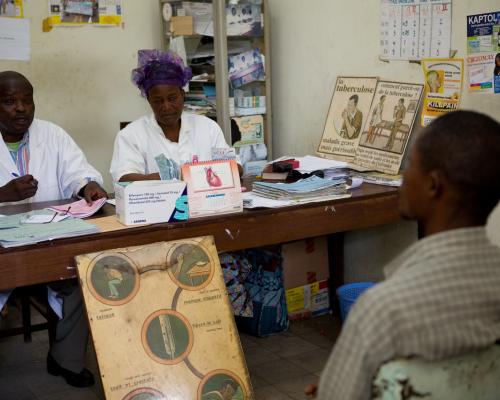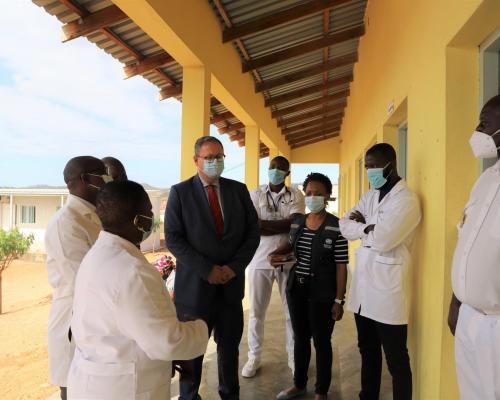Photo: WHO/Hugh Kinsella Cunningham
Ending the tenth Ebola outbreak in the Democratic Republic of the Congo means searching, sometimes at extraordinary lengths, for people who possibly may have been infected by someone they know but are afraid to be treated. Some people have taken to hiding in the forests; some keep moving to evade health workers and World Health Organization (WHO) community engagement officers, like Jonathan Katembo above, trained to search for people who came into contact unknowingly with a person infected with the virus. The point is to monitor their health condition and get them the medical care they need as quickly as possible if symptoms should occur.
Photo: WHO/Eric Ahassa
Ebola, it is often said, is a disease that kills through love. But just as often, it is a disease that spreads – and kills – because of fear. Love most likely spread the virus between the husband and wife who live in this tidy and now disinfected mud and timber house in the busy gold mining centre of Biakato, in north-eastern Ituri Province. After the husband and wife (who asked to not be named) developed Ebola virus symptoms within days of each other, they were transferred to the Mangina Ebola Treatment Center, where the infection was confirmed, and they remain in treatment. Fear now possibly jeopardizes the life of their adult daughter. Instead of staying in Biakato for a daily health check by the contact tracers (local community workers) once her parents were diagnosed, she fled to the forest.
Photo: WHO/Hugh Kinsella Cunningham
Concerned for the daughter’s health and anyone she might encounter, Dr Lamine Diassy (above), an epidemiologist and acting field coordinator with the World Health Organization (WHO), set out with his contact tracing team to search for the woman and persuade her to come home to be vaccinated and have her health monitored. Her evasive behaviour is not unusual, says Dr Lamine, explaining that fear of being identified as a contact is a common problem and often drives such disappearances.
Photo: WHO/Hugh Kinsella Cunningham
After learning that the family had farm land deep in the forest, Dr Lamine and his team resorted to motorbikes to negotiate what began as a bad road then soon deteriorated to barely visible forest track. Eventually, there was no track even the motorcycle could safely follow, and the team abandoned their transport, negotiating the final few kilometres on foot.
photo: WHO/Hugh Kinsella Cunningham
At the end of their journey, they found the hut used for resting by the young woman’s parents and other families when they go into the forest to harvest plantain banana, cacao and coffee. The daughter was nowhere to be seen. The farmers who Dr Lamine and his team found there in the forest shook their heads when asked about her, indicating they knew nothing of her whereabouts. She may well have been there, but no one was telling.
Photo: WHO/Eric Ahassa
"Even though we parked our motorbikes well away from the village and walked in quietly, the woman we were looking for was not there. People still fear being contacts and play cat-and-mouse games,” Dr Lamine says. “This fear complicates our job, but we need to keep seeking all people who are high-risk contacts in places hard to reach, via bad roads and in very dangerous places in order to stop Ebola.”
Photo: WHO/Hugh Kinsella Cunningham
Having failed to find the daughter, the WHO contract tracing team decided on a different strategy. They set up a vaccination site at the Mangina Ebola Treatment Center in the hope that the daughter and other relatives would come to visit the parents. In that space, with the comfort of the parents nearby, the health workers, like the woman above, and community tracers will try to calm the daughter’s fears, explain the risks she faces and offer to vaccinate her – if she emerges from her hiding.
Photo: WHO/Hugh Kinsella Cunningham
In this corner of Ituri Province, where the family lives and where the daughter is in hiding, the Ebola virus keeps circling back to the Biakato mining centre. It is brought by people seeking the safety and comfort of home as they develop symptoms, having contracted the virus in other places with active outbreaks. Although many other towns in North Kivu and Ituri provinces have seen an end to the transmission of Ebola, the virus is still circulating here in Biakato.
Photo: WHO/Hugh Kinsella Cunningham
Biakato is now one of the last Ebola hot zones – one that the tracing teams who continue trudging through the forest to find every known contact are determined to cool down. They have yet to locate the daughter. But they remain vigilant to chase after every lead, every possible location, no matter how deep into the forest it takes them, to find what they hope are the last possible Ebola cases. They say the work is hard and exhausting, but the only way to stop Ebola is to keep on seeking – and helping – anyone who has been infected.
Pour plus d'informations ou pour demander des interviews, veuillez contacter :
Collins Boakye-Agyemang
Communications and marketing officer
Tel: + 242 06 520 65 65 (WhatsApp)
Email: boakyeagyemangc [at] who.int (boakyeagyemangc[at]who[dot]int)
Saya Oka
Communications Officer, WHO Africa Health Emergencies Programme
Tel: +242 06 508 1009
Email: okas [at] who.int (okas[at]who[dot]int)











